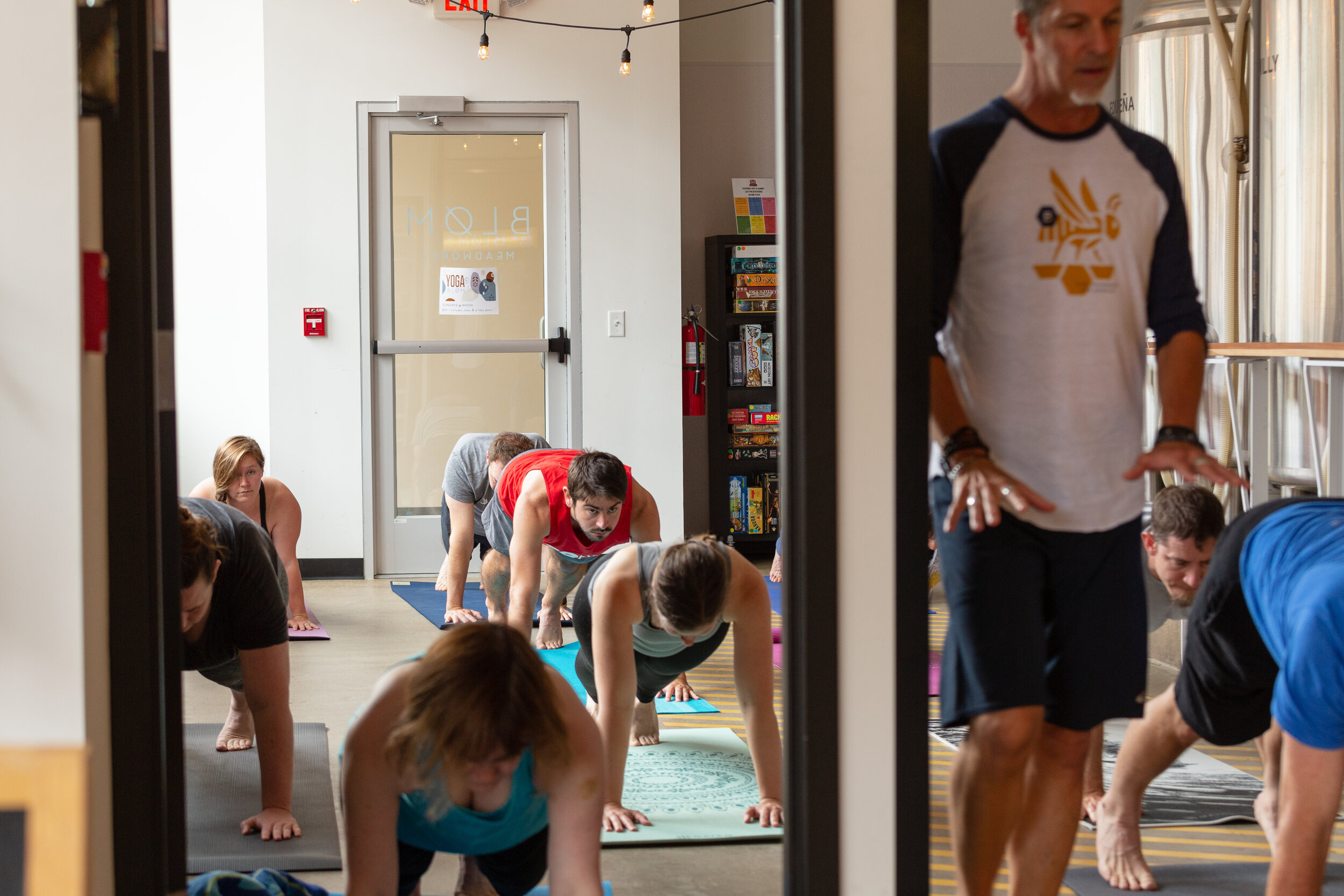It Was Infiltrating My Thoughts: This Ann Arbor mead maker turned her passion into a career
By Nicole Newman // Photos from tasteMAKERS and courtesy of Bløm Meadworks
“I think this crisis underlines the value and importance and dependability of a local food shed in connection with local makers, producers and farmers... It’s the reason our job is so important and interesting. We know how it was made and who grew it. We are really proud to share the makers stories and talk to customers about it.”
We met Lauren Bloom and Matt Ritchey while shooting an episode covering their Ann Arbor-based meadery, Bløm Meadworks (watch the full episode here). In the episode, Cat explored how Lauren and Matt use the highest quality, locally sourced honey in Michigan to create their carbonated, dry, session-style meads and ciders.
But long before we covered Lauren and Matt, they discovered their shared passion for mead. Nicole Newman caught up with Lauren to ask her more about Bløm Meadworks’ origins, how the current pandemic has imacted business and why she thinks the maker movement is important.
Nicole Newman: When we met you while shooting the episode, you told us about how opening the meadery was a natural combination for you and Matt. You wanted to stay in food advocacy and Matt loved experimenting with new recipes. Can you tell us about what you were doing before you opened the meadery?
Lauren Bloom: I worked for an education non-profit organization for several years. After that work, I spent a few years as an independent contractor and during that time, tried to weave local food sourcing and advocacy into my free time. At that point, it became apparent that I’d like to make that my career and it was what I wanted to spend my time on.
Matt had been working in financial software. It was at that job that he and two friends decided to start a brewery. They took the leap together. Matt was the head brewer but found out he couldn’t have gluten. So he took a step back because it was hard to be the head brewer but not be able to taste or test anything. He still owns part of the business.
NN: How did you get into food advocacy?
LB: There were two farmers’ markets that I would go to weekly — I would share information about food stamps or help vendors set up and tear down. Then, I applied to be on the board of Slow Food Chicago. I spent a year as a general board member and a year as co-vice president. That involved many things; a little bit of a jack of all trades. We had a large annual fundraiser featuring local farmers; we had a community garden in coordination with a Chicago community; a lot of it was consciousness-raising events about where our food comes from and working conditions for farmers. I think the tipping point was when I reached those moments when I was creating as much time as I could outside of work and it was infiltrating my thoughts and free time.
NN: What was the biggest lesson you learned from Slow Food Chicago?
LB: I think the biggest lesson was to listen. I don’t think our role as a local food organization was to be an expert. We needed to listen to farmers about what they were experiencing and how we could support them. We needed to listen communities of color and neighborhoods in Chicago. We needed to listen to citizens of Chicago who didn’t think they could make a difference in terms of local food purchasing.
NN: At what point did you and Matt decide to move to Ann Arbor and open Bløm Meadworks?
LB: We decided about a year after he found out he couldn’t drink beer and a year after I switched out of the non-profit sector in an effort to create more space for this. We realized there was a potential overlap in what we wanted to do, but we couldn’t find jobs that had that overlap, so we created it for ourselves.
NN: How do your meads differ from traditional mead?
LB: I’ll start with how they’re similar because that’s a shorter conversation. They have the same ingredients. They have honey, mead and water. At that point they diverge from traditional mead. Traditional mead is high in alcohol content and sugar content. It is also thicker in texture. It’s often still and you consume it around room temperature. And because of the honey content, it’s often fairly expensive. Which it should be because honey is very expensive to work with.
We swing to the other end of the spectrum. Our meads are all carbonated. They’re 5 to 7% alcohol. And they’re all for the most part dry. They’re refreshing, light, bright. They are less expensive because we use less honey to lower the alcohol content.
Often, traditional mead is more of a celebratory beverage for a special occasion. We felt there was an opportunity to take mead and the base ingredients and turn it into a drink that felt casual and light. You drink it on your porch, at a barbecue, even just sitting around the table.
NN: I’ve heard of CSA, but you run a CSM — Community Supported Mead program. Tell me more about that.
LB: We came up with this idea when Matt started the brewery in Chicago. The idea for a CSA is that you’re pre-paying a farmer for a portion of the crop throughout the growing season. It’s insurance for the farmer and an acknowledgment from you that you know things may be unpredictable due to the seasons. Our product is a bit more predictable. You’re signing up for a six-month membership. We give you a glass and you get a growler each month and some other perks. We also have one member-only event per six-month period. We usually like to engage folks in the production process. We also really rely on that group for feedback about flavors and other things.
NN: In the episode, we learn that you are affiliated with Michigan State University. You’re also located in Ann Arbor, home of the University of Michigan. Is teaching something that is important to you?
LB: Yes! I don't think we could do this job if teaching wasn’t important to us. If nothing else, because mead is pretty unfamiliar to people. More folks are familiar with cider. That industry has grown with craft beer but mead is far behind. Our regulars know about it but people who walk in the door generally do not know what it is and are hesitant to try it. We’re often starting from scratch explaining what mead is or we’re talking to someone who has had more traditional mead. So pretty much every conversation we have is a teaching moment.
We also have attended a couple bee-keeping conferences and presented about session mead and home brewing. Every month, we had a monthly tour that people could taste through the honey and sample the mead and cider. They’ll walk through the cellar and production area.
NN: Lets pivot topics a bit. I’d like to chat about the impact COVID-19 has had on your business. Would you mind telling me about that?
LB: COVID-19 has hit Michigan particularly hard for several reasons. Within that, our communities of color have been extraordinarily over-represented in the number of cases and deaths. Michigan shut down completely and we were very supportive of that. The very first week, we pivoted and offered curbside pickup. We also offered local delivery for a week. We decided to close that down temporarily, regroup, and make sure that we had practices that were contact-less. We took two weeks off and came up with a rigorous rubric of how to offer those services. I think what’s next for us is to-go, and then after that, distanced outdoor seating.
We’ve been fortunate enough to receive federal loans. I think one thing that’s misleading for retail businesses is that our sales numbers are okay. They may be 30 to 40% of what they are when they’re open. The harder part is the margins for to-go sales are much lower.
NN: Why do you think the maker movement is important?
LB: I think this crisis underlines the value and importance and dependability of a local food shed in connection with local makers, producers and farmers. When there were shortages at the beginning at so many of the large stores, our small, independent stores were able to connect local makers and get the things people needed for folks. We could pivot quickly and work efficiently. This is a magnified example of why it’s so important. It’s the reason our job is so important and interesting. We know how it was made and who grew it. We are really proud to share the makers stories and talk to customers about it.
NN: Do you have a favorite mead?
LB: My favorite is our rhubarb mead. Every year we purchase about 1,200 pounds of rhubarb from a farmer on the Leelanau Peninsula in Michigan. He harvests it for us and we wash it, freeze it and ferment it. It’s really dry, it’s tart. It’s mineral-y. It’s a chance to taste rhubarb without sugar or custard or all the normal things it’s in.
NN: Do you have a favorite merch item in our marketplace?
LB: I would say my favorite is our five-panel gray hat. When we were searching for a location, we wanted to be in downtown Ann Arbor because there’s a fabric of independent businesses here. We wanted to collaborate with them. We didn’t know if that intent would come to fruition but that far and away has become the highlight of being here. Collaborating with other businesses. And we do a lot of events for the cycling community. That hat style was inspired by the cycling community we get to work with here.
NN: What’s your end goal? Where do you hope to see Bløm in the future?
LB: I have two goals. One of them would be a sustainable growth model where we’re never exceeding the ability to buy from farmers that we know who grow locally. Making sure we are responsible in growth. We don’t have any plans to become really large or sell the business. We are in it because we love being a part of it.
The other end goal, and this one is slower, but [we want] to raise general awareness of the existence of session mead. Letting folks out there know that there’s an alternative to beer that invests economically at two levels. By purchasing with us, you’re supporting the community and Michigan farmers.








